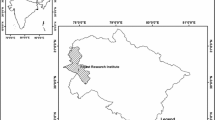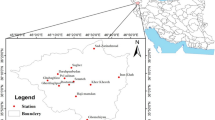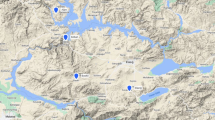Abstract
Climate plays a dominant role in influencing the process of evaporation and is projected to have adverse effects on water resources especially in the wake of a changing climate. In order to understand the impact of climate change on water resources, artificial intelligence models that possesses rapid decision-making ability, are used. This study was carried out to estimate evaporation in the Karaidemir Reservoir in Turkey with artificial neural networks (ANNs). The daily meteorological data covering the irrigation season were provided for a 30-year reference period and used to develop artificial neural network models. Predicted meteorological data based on climate change projections of HadGEM2-ES and MPI-ESM-MR under the Representative Concentration Pathway (RCP) 4.5 and 8.5 future emissions scenarios between 2000–2098 were utilized for future evaporation projections. The study also focuses on optimal crop patterns and water requirement planning in the future. ANNs model was run for each of the scenarios created based on ReliefF algorithm results using different testing-training-validation rates and learning algorithms of Bayesian Regularization (BR), Levenberg–Marquardt (L-M) and Scaled Conjugate Gradient (SCG). The performance of each alternative model was compared with coefficient of determination (R2) and mean square error (MSE) measures. The obtained results revealed that the ANNs model has high performance in estimation with a few input parameters, statistically. Projected surface water evaporation for the long term (2080–2098) showed an increase of 1.0 and 3.1% for the RCP4.5 scenarios of the MPI and HadGEM model, and a 14% decrease and 7.3% increase for the RCP8.5 scenarios, respectively.




Similar content being viewed by others
Availability of Data and Materials
All authors certify that they have no affiliations with or involvement in any organization or entity with any financial interest or non-financial interest in the subject matter or materials discussed in this manuscript. The authors have no financial or proprietary interests in any material discussed in this article.
References
Abed M, Imteaz MA, Ahmed AN, Huang YF (2022) Modelling monthly pan evaporation utilizing Random Forest and deep learning algorithms. Sci Rep 12:13132
Alejo LA, Alejandro AS (2022) Changes in irrigation planning and development parameters due to climate change. Water Resour Manag 36:1711–1726
Allawi MF, Othman FB, Afan AA, Ahmed AN, Hossain S, Fai CM, El-Shafie A (2019) Reservoir evaporation prediction modeling based on artificial intelligence methods. Water 11:1226. https://doi.org/10.3390/w11061226
Allen RG, Pereira LS, Raes D, Smith M (1998) Crop evapotranspiration: Guidelines for computing crop water requirements. FAO Irrig Drain Rome, Italy. p. 56
Boger Z, Guterman H (1997) Knowledge extraction from artificial neural network models. IEEE Int Conf Syst Man Cybern Comput Cybern Simul 4:3030–3035
Bou-Fakhreddine B, Mougharbel I, Faye A, Pollet Y (2019) Estimating daily evaporation from poorly-monitored lakes using limited meteorological data: A case study within Qaraoun dam – Lebanon. J Environ Manag 241:502–513
Budak H (2018) Feature selection methods and a new approach. SDU J Nat Appl Sci 22(SI):21–31
da Costa EMB, Lucio PS, Maia AG (2021) Relevance of reservoir morphometry in the evaporation process: an evaporation model for semi-arid regions. Water Resour Manag 35:4895–4907
Deswal S, Pal M (2008) Artificial neural network based modeling of evaporation losses in reservoirs. Inter J Civil Environ Engin 2(3):18–22
Doorenbos J, Kassam AH (1979) Yield response to water. FAO Irrig Drain Pap No. 33 Rome, Italy, p. 193
El-Mahdy SM, El-Abd WA, Morsi FI (2021) Forecasting lake evaporation under a changing climate with an integrated artificial neural network model: A case study Lake Nasser. Egypt J Afr Earth Sci 179:104191
Fan J, Chen B, Wu L (2018) Evaluation and development of temperature-based empirical models for estimating daily global solar radiation in humid regions. Energy 144:903–914
Feng Y, Peng Y, Cui N (2017) Modeling reference evapotranspiration using extreme learning machine and generalized regression neural network only with temperature data. Comput Electron Agric 136:71–78
Feng Y, Jia Y, Zhang Q (2018) National-scale assessment of pan evaporation models across different climatic zones of China. J Hydrol 564:314–328
GDSHW (2018) Kızılırmak basin master plan report. General Directorate of State Hydraulic Works, Ministry of Forestry of Water Management, Turkey
GDWM (2021) General directorate of water management database. https://suen.gov.tr/Suen/en/default.aspx. Accessed 26 Mar 2022
Ghaemi A, Rezaie-Balf M, Adamowski J, Kisi O, Quilty J (2019) On the applicability of maximum overlap discrete wavelet transform integrated with MARS and M5 model tree for monthly pan evaporation prediction. Agric for Meteorol 278:107647
Goyal MK, Bharti B, Quilty J (2014) Modeling of daily pan evaporation in sub-tropical climates using ANN, LS-SVR, Fuzzy Logic, and ANFIS. Expert Syst Appl 41(11):5267–5276
IPCC (2001) Climate change 2001: The scientific basis. Contribution of Working Group Ito the 3rd Assessment Report of the Intergovernmental Panel on Climate Change, edited by J. T. Houghton et al., 881 pp., Cambridge Univ. Press, New York
IPCC (2007) Climate change 2007: The scientific basis. Contribution of Working Group Ito the 4th Assessment Report of the Intergovernmental Panel on Climate Change, edited by S. Solomon et al., Cambridge Univ. Press, New York
Islam Z (2011). A review on water resources management modeling. https://doi.org/10.13140/2.1.3496.0168
Jensen ME, Burman RD, Allen RG (1990) Evapotranspiration and irrigation water requirements. ASCE Man Rep Eng Pract No.70, New York, pp. 332
Keskin ME, Terzi O (2006) Artificial neural network models of daily pan evaporation. J Hydrol 11:65–70
Kim S, Shiri J, Kisi O (2012) Pan evaporation modeling using neural computing approach for different climatic zones. Water Res Manag 26(11):3231–3249
Kisi O (2013) Evolutionary neural networks for monthly pan evaporation modeling. J Hydrol 498(12):36–45
Kolokytha E, Malamataris D (2020) Integrated water management approach for adaptation to climate change in highly water stressed basins. Water Resour Manag 34:1173–1197
Lu X, Ju Y, Wu L, Fan J, Zhang F, Li Z (2018) Daily pan evaporation modeling from local and cross-station data using three tree-based machine learning models. J Hydrol 566:668–684. https://doi.org/10.1016/j.jhydrol.2018.09.055
Malik A, Kumar A, Kisi O (2017) Monthly pan-evaporation estimation in Indian central Himalayas using different heuristic approaches and climate based models. Comput Electron Agric 143:302–313
Majhi B, Naidu D (2021) Pan evaporation modeling in different agroclimatic zones using functional link artificial neural network. Inf Process Agric 8:134–147
Moazenzadeh R, Mohammadi B, Shamshirband S, Chau KW (2018) Coupling a firefly algorithm with support vector regression to predict evaporation in northern Iran. Eng Appl Comput Fluid Mech 12:584–597
Moghaddamnia A, Ghafari GM, Piri J, Amin S, Han D (2009) Evaporation estimation using artificial neural networks and adaptive neuro-fuzzy inference system techniques. Adv Water Resour 32:88–97
Nourani V, Elkiran G, Abdullahi J (2019) Multi-station artificial intelligence based ensemble modeling of reference evapotranspiration using pan evaporation measurements. J Hydrol 577:123958. https://doi.org/10.1016/j.jhydrol.2019.123958
Novotná B, Jurík L, Cimo J, Palkovic J, Chvíla B, Kišš V (2022) Machine learning for pan evaporation modeling in different agroclimatic zones of the Slovak Republic (Macro-Regions). Sustain 14:3475
Penman HL (1948) Natural evaporation from open water, bare soil and grass. Proc Royal Society, London 193:120–145
Priestley CHB, Taylor RJ (1972) On the assessment of surface heat flux and evaporation using large-scale parameters. Mon Weather Rev 100(2):81–92
Robnik-Šikonja M, Kononenko I (2003) Theoretical and empirical analysis of ReliefF and RReliefF. Mach Learn 53:23–69
Sanikhani H, Kisi O, Nikpour MR (2012) Estimation of daily pan evaporation using two different adaptive neuro-fuzzy computing techniques. Water Resour Manag 26(15):4347–4365
Seifi A, Soroush F (2020) Pan evaporation estimation and derivation of explicit optimized equations by novel hybrid meta-heuristic ANN based methods in different climates of Iran. Comput Electron Agric 173:105418. https://doi.org/10.1016/j.compag.2020.105418
Senent-Aparicio J, López-Ballesteros A, Cabezas F, Pérez-Sánchez J, Molina-Navarro E (2021) A modelling approach to forecast the effect of climate change on the tagus-segura interbasin water transfer. Water Resour Manag 35:3791–3808
TSMS (2020) Turkish state meteorological agency database. https://www.mgm.gov.tr/eng/forecast-cities.aspx. Accessed 26 Mar 2022
UNESCO, UN-Water (2020) United nations world water development report 2020: water and climate change, Paris
Wright S (1921) Correlation and causation. J Agric Res 20(7):557–585
Wu L, Huang G, Fan J, Ma X, Zhou H, Zeng W (2020) Hybrid extreme learning machine with metaheuristic algorithms for monthly pan evaporation prediction. Comput Electron Agric. https://doi.org/10.1016/j.compag.2019.105115
Yuguda TK, Li Y, Zhang W, Ye Q (2020) Incorporating water loss from water storage and conveyance into blue water footprint of irrigated sugarcane: A case study of Savannah Sugar Irrigation District. Nigeria Sci Total Environ 715:136886
Funding
The authors declare that no funds, grants, or other support were received during the preparation of this manuscript. The authors have no relevant financial or non-financial interests to disclose.
Author information
Authors and Affiliations
Contributions
All authors contributed to the study conception and design. Material preparation, data collection and analysis were performed by Yeşim Ahi, Çiğdem Coşkun Dilcan, Daniyal Durmuş Köksal and Hüseyin Tevfik Gültaş. The first draft of the manuscript was written by Yeşim Ahi and all authors commented on previous versions of the manuscript. All authors read and approved the final manuscript.
Corresponding author
Ethics declarations
Informed Consent
Not applicable.
Consent to Participate
All authors agree with the content and that all give explicit consent to submit.
Consent to Publish
All authors have read and agreed to the published version of the manuscript.
Research Involving Human Participants and/or Animals Informed Consent
Not applicable.
Conflicts of Interest
In the study, there is no any potential conflicts of interest. We hereby confirm that this work has not been published elsewhere and that it has not been submitted simultaneously for publication elsewhere. There are no conflicts of interest to disclose.
Additional information
Publisher's Note
Springer Nature remains neutral with regard to jurisdictional claims in published maps and institutional affiliations.
Highlights
• The study proved that the artificial neural network model is superior in predicting surface evaporation.
• The study reveals the change in current water resource potential based on climate scenarios.
• It is important to make accurate future projections in terms of water resources management.
• The study focused on the irrigated area estimation based on water allocated from reservoir.
• The model could also guide decision-makers and stakeholders in the context of sectoral water needs.
Rights and permissions
Springer Nature or its licensor (e.g. a society or other partner) holds exclusive rights to this article under a publishing agreement with the author(s) or other rightsholder(s); author self-archiving of the accepted manuscript version of this article is solely governed by the terms of such publishing agreement and applicable law.
About this article
Cite this article
Ahi, Y., Coşkun Dilcan, Ç., Köksal, D.D. et al. Reservoir Evaporation Forecasting Based on Climate Change Scenarios Using Artificial Neural Network Model. Water Resour Manage 37, 2607–2624 (2023). https://doi.org/10.1007/s11269-022-03365-0
Received:
Accepted:
Published:
Issue Date:
DOI: https://doi.org/10.1007/s11269-022-03365-0




